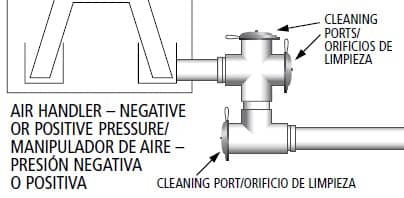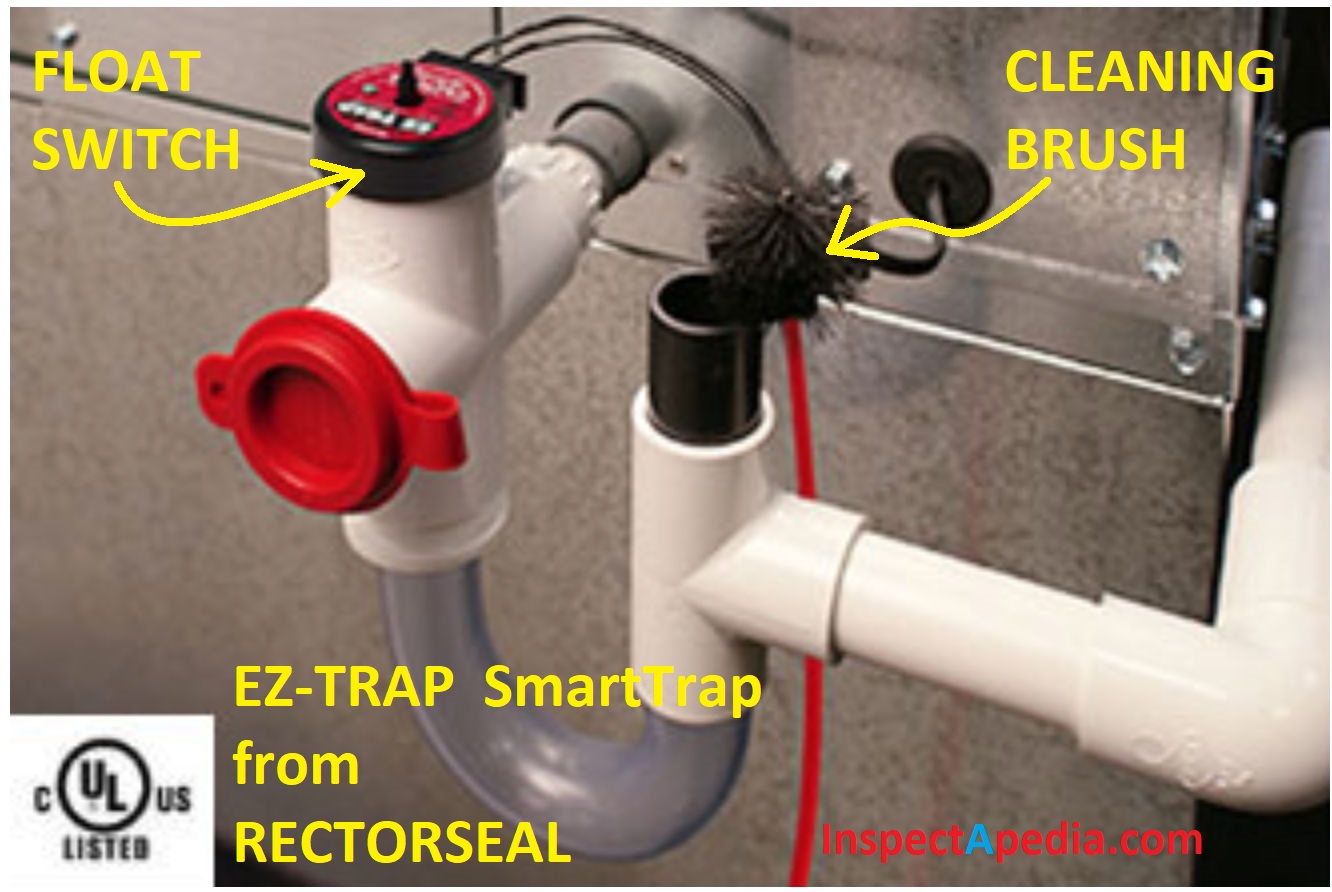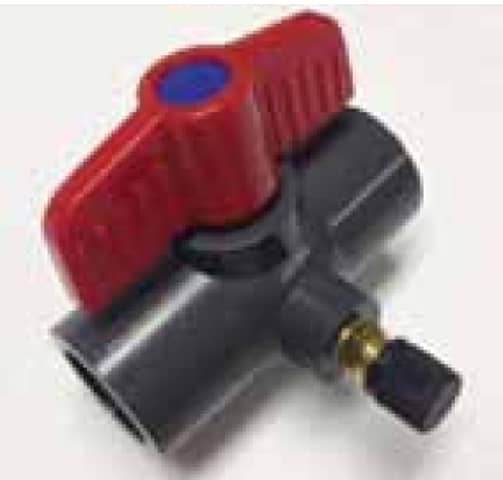 How to Clean or Un-Clog an Air Conditioning or Heat Pump Condensate Drain Line or Trap
How to Clean or Un-Clog an Air Conditioning or Heat Pump Condensate Drain Line or Trap
- POST a QUESTION or COMMENT about how to un-block a clogged A/C or heat pump condensate drain
A/C condensate drain de-clog & cleanout: this how-to article explains procedures for cleaning or de-clogging a sluggish, blocked, or leaky air conditioning or heat pump condensate drain.
Condensate drain cleaning and unclogging tools and methods are reviewed, including simple steps that a homeowner can take to clear a blocked condensate drain at little or no cost.
InspectAPedia tolerates no conflicts of interest. We have no relationship with advertisers, products, or services discussed at this website.
- Daniel Friedman, Publisher/Editor/Author - See WHO ARE WE?
How to Un-Clog an Air Conditioning or Heat Pump Condensate Drain to Avoid Leaks & Damage
A clogged condensate drain can cause air conditioner problems or even loss of cooling
-
Condensate may overflow into the building, causing water damage or even a costly mold contamination problem
- Condensate that fails to make it through a clogged drain line may spill into a condensate overflow pan that uses a sensor switch (instead of a second condensate drain line) to turn off the entire air conditioning system rather than risk leak damage.
See CONDENSATE PAN SWITCH LOCKOUT - Clogged condensate may accumulate in a location where it breeds bacteria, other pathogens, or even mosquitoes.
What Causes A/C Condensate Drain Line Clogging?
 A/C or heat pump condensate drains can become clogged, leading to condensate leaks, spillage, or even bacterial hazards in a building.
A/C or heat pump condensate drains can become clogged, leading to condensate leaks, spillage, or even bacterial hazards in a building.
Clogged air conditioner condensate drain lines can form another source of air conditioner or heat pump condensate leakage that can in turn lead to hidden water damage or in some locations an indoor mold problem or bacterial contamination.
Our photograph of a nearly full A/C condensate overflow pan (at left) shows what can happen if the primary condensate air conditioner condensate drain line is clogged and worse, the condensate drain overflow pan is also itself clogged and not draining properly.
Luckily we caught this attic mold and bacterial pond before it had soaked the ceilings below.
We see air conditioner or heat pump condensate drain lines clogging for several reasons:
- Condensate trap debris dry-out cycle:
Dust and debris or nearby insulation entering the condensate drain line trap near the air handler, often where the trap design includes a vertical standpipe open to the air, serving as an emergency overflow to prevent condensate from backing up inside the air handler itself.
In months during which an air conditioning system is not in use, particularly for non-heat-pump systems that perform cooling-only, condensate and accumulated dust and debris that was resting in the condensate drain trap can convert to a dried plug of crud as the water portion of the condensate evaporates.
After several years of this wet, sludge accumulation, and then drying cycle, the plug of dried sludge in a condensate trap or drain can actually block condensate flow through the system. - Improperly-installed condensate drain lines
with a long near-horizontal run can allow dust and debris to accumulate, dry, and ultimately block condensate flow in the drain line - Insects,
insect nests, or on larger piping systems, even rodents can clog a condensate drain line. - Condensate overflow pan drain blockage:
dust and debris also accumulate readily in a condensate overflow pan where it can flow to and block the opening to the overflow pan's independent condensate drain line.
If a blockage occurs here, the condensate overflow pan may not do its job of preventing condensate spillage into the building. (Ref. Uniform Mechanical Code Sec. 1205 and Sec. 510. Condensate overflow pan is suggested for attic space per UMC (Uniform Mechanical Code) Section 1205.)
How do I Clean an Air Conditioning or Heat Pump Condensate Drain?

- Remove visible debris
from the clogged air conditioning or heat pump condensate drain: start with a simple visual inspection. You may see a plug of crud blocking a condensate overflow pan right at its drain inlet - material that can be manually removed and the area wiped clean.
Peering into the standpipe at a condensate drain trap, you may see crud right in that area that can be fished out or simply loosened and flushed through the drain line by working carefully so as not to break or loosen any pipe connections.
Our photo shows a poorly-installed A/C condensate drain system: the air handler condensate drain is installed in common with the overflow pan drain line - so that a blockage in the condensate drain line will guarantee that condensate spills onto the attic floor.
The A/C condensate tray should have either had its own independent drain line, or it should have been installed with a sensor switch that shuts down the A/C or heat pump system if spillage is detected in the overflow pan.
Finally, there is no trap on the condensate line and no air vent.

- Snake the clogged A/C condensate line carefully using a condensate drain brush or plastic tube:
We've loosened and freed a clogged condensate drain line by simply snaking the line gently with a piece of plastic tubing inserted at the trap vent and pushed through the condensate trap.
Remember that because condensate drain piping is usually 3/4" plastic piping you don't want to use unnecessary force that could result in breaking any pipe or causing a leak at a connection. Gently does the trick most of the time.
Our photo (left) shows an EZ TRAP installation at a condensate drain pipe right at the air handler. Notice those three red plastic caps?
Each of those is an access port through which this air conditioning condensate trap and drain can be quickly and inexpensively cleaned.
Notice that small black bristle brush clipped to the upper red cap in the center of our photo. The brush has a flexible blue plastic handle, allowing the homeowner or A/C heat pump service technician to easily push the brush through the trap and drain line to clean it.
Because most A/C condensate drain clogs occur right at the trap, this is the quickest, easiest, lowest-cost method to clean and clear an A/C or heat pump condensate drain clog.
Air conditioner / heat pump condensate traps with cleanout ports can be cleaned using soapy water and the manufacturer-provided cleaning brush. Some models can be easily disassembled for further cleaning of internal parts.
Condensate traps that include cleanout caps include the EZT-150 EZ-Trap and UltraTrap (sketch at below left) that work on both positive or negative pressure air handlers. Below we provide a link to installation instructions for the condensate drain trap provided by AirTech Products shown at below-left.
- Using a plumbing snake to clear a condensate line: In some cases a clog might occur in an A/C - heat pump condensate drain that is beyond the reach of your drain cleaning brush.
Try a longer length of flexible plastic tubing as a gentle condensate drain snake, use a small plumbing drain snake, or try the remaining A/C condensate drain clog clearing methods listed below. For long condensate drain line runs, you may need to install additional cleanout ports in the line such as the EasyKlear cleanout port discussed just below.
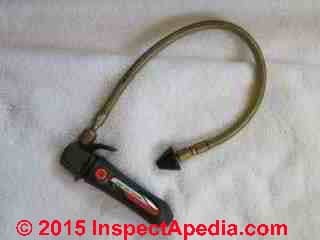
- Using a CO2 cartridge
to blast out a clogged A/C or heat pump condensate drain line is a method followed by some service techs. Heating or air conditioning equipment suppliers sell a small CO2 cartridge canister with an outlet adapter and fittings to connect to various sizes of piping.
The canister is connected to the condensate drain line inlet (and the vent at the drain plugged with an expandable rubber plug sold for that purpose).
A CO2 cartridge is dropped into the canister and its cap screwed on. Screwing the canister top on tightly will puncture the CO2 cartridge, sending a quick shot of high pressure gas through the drain line, clearing an obstruction. (This method is also widely used by oil heat service technicians to clear a clogged heating oil line.)
We have found this a very helpful tool that will sometimes blast an obstruction through a condensate drain system. However in working on split system air conditioners whose condensate drain opening is difficult to access you may find that you cannot get the rubber condensate drain line plug securely in place.
See SPLIT SYSTEM AC CONDENSATE LEAK REPAIR - Vacuum clean the clogged condensate drain line:
Use a manual pump to vacuum clean a clogged air conditioning or heat pump condensate drain line. The pump inlet side is connected by an adapter fitting to the condensate drain line opening.
You'll have to plug the nearby vertical standpipe at the condensate trap if one is provided. The manual condensate drain line pump's outlet side is connected to a hose run into a bucket or a nearby building drain to receive any waste.- Portable pumps for condensate drain cleaning include
- A/C Drain Sucker from ClenAir Manufacturing, Inc., P.O. Box 346 Ft. Washington, PA 19034, Website: http://www.clenair.com/
- Drain Dawg & Clear Vue Condensate Pump from DiversiTech. DiversiTech Condensate Drain Cleaner Pump, from Torroc.com Website: www.clearvuepump.com
- Little Giant Condenate Drain Pump. In December 2014 the company's website was not working but their products are widely available from plumbing and HVAC suppliers. Quoting from Fraknlin-Electric, a supplier of Little Giant pumps, "Little Giant condensate removal pumps are engineered for a wide range of specific air conditioning, refrigeration, and heating applications, as well as may other automatic drain uses." - http://www.franklin-electric.com/hvac/condensate-removal.aspx
- Mighty Pump - we removed the live link for this product after a reader reported that the recommendation for this device was posted by Stuart Oakner the owner of the company who posted suggestions without so identifying himself. Details are at FAQs in this article.
InspectAPedia is an independent publisher of building, environmental, and forensic inspection, diagnosis, and repair information provided free to the public - we have no business nor financial connection with any manufacturer or service provider discussed at our website.
Condensate Drain Line Cleanouts, Access Ports, Blow-out or Vacuum-out Valves & Fittings
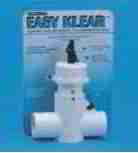 We like the clogged condensate drain vacuum cleaning approach better than the blow-out approach if we can get this method to work because it is more gentle, reducing the risk of damaged piping, and because we minimize the risk of blowing a plug of crud downstream to a more distant location where it can form a new clog or plug in a long condensate piping run.
We like the clogged condensate drain vacuum cleaning approach better than the blow-out approach if we can get this method to work because it is more gentle, reducing the risk of damaged piping, and because we minimize the risk of blowing a plug of crud downstream to a more distant location where it can form a new clog or plug in a long condensate piping run.
[Click to enlarge any image]
Several air conditioning and plumbing suppliers provide easy-to-clean air conditioning condensate cleanout ports such as the one shown above, including the Easy Klear condensate line cleanout (photo at left) that is particularly useful if your condensate drain line has a long run with a slope of less than 1/8" per foot.
This A/C or heat pump condensate drain line cleanout is intended to be vacuumed using a connection to a shop vac.
- Blow out the clogged condensate drain line: Use a compressed air source or a manual pump such as the Mighty Pump (safer) to try blowing out the clogged air conditioning or heat pump condensate drain line and trap.

Using a manual pump, the pump's outlet end is connected to the condensate drain opening or standpipe, any other nearby openings are plugged, and you use the pump to try to force the blockage through the system to an outlet.
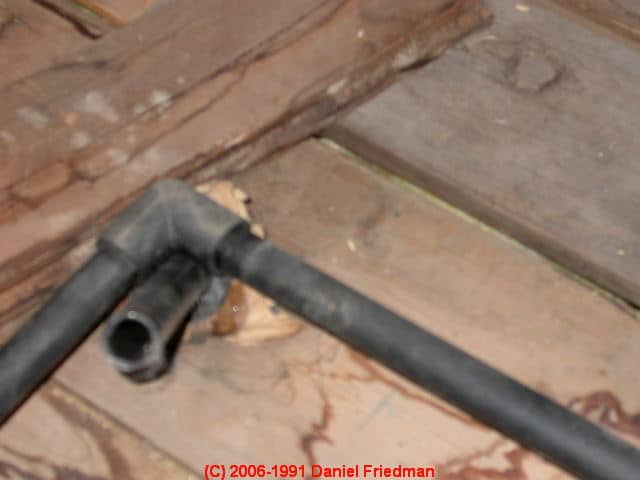
This approach works best if the condensate drain line is actually fully clogged and full of standing water or condensate.
Watch out: using high pressure to try to blow out a clogged drain pipe of any kind can result in damaging the drain piping, causing it to break or come disconnected, spilling ugly condensate and crud all over.
This risk is greatest if the original piping connections were not properly glued or were not soundly made in the first place.
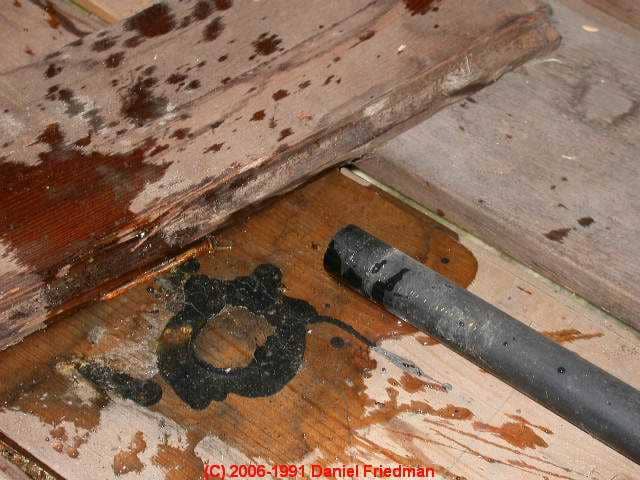
Above: condensate drain piping blown apart during drain cleaning efforts in a building attic.
- EZ Trap condernsate trap from Rectorseal. [Illustrated above]
Rectorseal provides a series of condensate handling controls and devices including the EZ TRAP shown in our photo of an installed condensate drain trop with cleanout caps provided by an InspectApedia.com reader.
The flexible cleaning brush, provided by the manufacturer, can be seen atop the trap at upper center of the photo.
The company's products include
100 Series ClearTrap Kits, simliar to the condensate trap in our photo wbut using a clear plastic U portion of the trap so that one can easily see if the drain is clogged, dirty, or properly filled with condensate water.
200 Series SmartTrap kits that include a float switch for overflow protection along with the clear trap U mentioned above.
220 Series Overflow Switches - float switches that can shut down the A/C or heat pump system if condensate is not draining
100 Series Waterless kits that provide freeze protection of the condensate drain system
660 Series combo kit combining a clear trap with an overflow switch.
Contact: RectorSeal® 2601 Spenwick Drive Houston TX 77055 Tel : 713-263-8001 / 800-231-3345 Fax : 713-263-7577 / 800-441-0051 E-mail : techservice@rectorseal.com customerservice@rectorseal.com Website: https://www.rectorseal.com/ez-trap/
Above: details of the SmartTrap from Rectorseal showing the float switch, cleaning brush, and clear tubing used for the trap body.
Reader suggests the Jones JV-1 AC Condensate Line Blow-Out Valve
5/1/2014 Tom Kolter
You should check out the Jones Valve, too, available at Supco and Watso, United Refrigeration and Johnstone, the latter two as "Line Drive".
Sources for A/C or heat pump condensate drain blow-out valves (remember our warning above?)
- JV1-Jones Valve Condensate Drain Blow-Out Valve, is available from SUPCO HVAC parts, Website: http://www.supco.com/. Email: orders@supco.com, Tel: 1-800-458-2818
The Jones JV1 blow out valve product is a plastic valve that includes a flare fitting that will allow the connection of a CO2 or Nitrogen tank of compressed gas used to "blow out" the condensate line clog.
The valve attaches to a 3/4" condensate drain line and provides a 1/4" male flare fitting that incorporates a "one-way" internal Schrader valve to permit air to blow into the valve but won't leak out.
Price: the JV1 Jones blowout valve typically at less than $10. U.S. - Jones Valve condensate drain cleanout: Gemaire Distributors, Website: http://www.gemaire.com (if you don't mind having to listen to a recorded song) Gemaire describes the valve as:
The Jones Valve is a simple condensate blow-out valve that is inexpensive and easy to use. Simply attach your nitrogen or compressed air tank hose to the 1/4" flare fitting on the Jones Valve, turn the handle 90°, and open the gas slowly to the line.
Turn the handle 180° and clear out the other side of the line. Make sure the arrow (indicating air port) is pointing to the back side of the Jones Valve after service is complete.

- All-Access condensate drain line cleanout device, MSD Research, Inc., Boca Raton, FL 33428, Email: Sales@MSDResearch.net,
Website: http://allaccessdevice.com, provides a condensate drain line fitting that permits connection to a wet-vac or to an air (or gas) pressure source to remove blockages without having to cut the condensate drain line apart.
Thanks to All-Access for notifying us of condensate drain maintenance requirement updates in the ICC IMC 307.2.5 & IRC M1411.3.3 Drain Line Maintenance code for 2015.
That code is discussed
at CONDENSATE DRAINS, CODES
Watch out: Cleaning out partly-blocked, sluggish A/C or heat pump condensate lines:
neither the vacuum method nor the blow-out method will work very well for cleaning a sluggish condensate line that is not totally blocked, since you may simply move air past the blockage rather than removing it.
If you encounter this problem, try hooking up your pump in the "blow-out" configuration, then try filling the condensate line with tap water so that the pump pressure can act mechanically on the clog.
Watch out: connecting a blow-out device or a vacuum device to a condensate drain that is connected to building plumbing drain waste or vent piping may cause some trouble.
These devices should work well for condensate drains directed to the building exterior but depending on piping arrangement (and eschewing for a moment the fact that DWV connections of condensate drains are not recommended without an air gap) using a shop vac you may pull wastewater or even sewage back into the condensate drain.
Thank you to our readers for their generous comments
(May 13, 2011) Chris Nallie-Courtney said: Thank you! This was very helpful. I was able to clean out my drain line myself.
(June 22, 2011) w.m.cutler said: very educational,did all the work myself,replaced trap and cleanout 3/4 pvc,used air and shop vac. system fine now.
(Sept 25, 2011) Rana said: Thanks so much! I was able to clean out the drain myself rather than take off work to wait for the A/C tech to come out. And I'm happy to know more about the upkeep of my own home.
(June 20, 2014) Linda Vereen said: Learned so much from your site. What a great service you provide. Love that you post pictures and details, it makes it easy to understand. thank You
(July 17, 2012) Ann Borg said: All of the information on your website was excellent. Thank you.
...
...
Continue reading at Legionella BACTERIA & HVAC EQUIPMENTor select a topic from the More Reading links just below or see the ARTICLE INDEX.
Or see CONDENSATE DRAIN CLEAN & DE-CLOG FAQs - questions & answers about how to un-clog or un-block an A/C or heat pump condensate drain line, posted originally at this page.
Or see these
HVAC Condensate Articles
- CONDENSATE HANDLING, HVAC
- CONDENSATE LEAKS
- CONDENSATE PUMPS
- CONDENSATE DISPOSAL, IMPROPER
- CONDENSATE DRAINS, CODES
- CONDENSATE DRAIN CLEAN & DE-CLOG
- CONDENSATE DRAIN INSULATION REQUIREMENTS
- CONDENSATE DRAIN PROBLEMS
- CONDENSATE DRIP TRAY DEFECTS
- CONDENSATE PAN SWITCH LOCKOUT
- Legionella BACTERIA & HVAC EQUIPMENT
- CONDENSING BOILER/FURNACE CONDENSATE DRAIN
- SPLIT SYSTEM AC CONDENSATE LEAK REPAIR
- CONDENSING BOILER/FURNACE CONDENSATE DRAIN
Suggested citation for this web page
CONDENSATE DRAIN CLEAN & DE-CLOG at InspectApedia.com - online encyclopedia of building & environmental inspection, testing, diagnosis, repair, & problem prevention advice.
Or see this
INDEX to RELATED ARTICLES: ARTICLE INDEX to AIR CONDITIONING & HEAT PUMPS
Or use the SEARCH BOX found below to Ask a Question or Search InspectApedia
Ask a Question or Search InspectApedia
Try the search box just below, or if you prefer, post a question or comment in the Comments box below and we will respond promptly.
Search the InspectApedia website
Note: appearance of your Comment below may be delayed: if your comment contains an image, photograph, web link, or text that looks to the software as if it might be a web link, your posting will appear after it has been approved by a moderator. Apologies for the delay.
Only one image can be added per comment but you can post as many comments, and therefore images, as you like.
You will not receive a notification when a response to your question has been posted.
Please bookmark this page to make it easy for you to check back for our response.
IF above you see "Comment Form is loading comments..." then COMMENT BOX - countable.ca / bawkbox.com IS NOT WORKING.
In any case you are welcome to send an email directly to us at InspectApedia.com at editor@inspectApedia.com
We'll reply to you directly. Please help us help you by noting, in your email, the URL of the InspectApedia page where you wanted to comment.
Citations & References
In addition to any citations in the article above, a full list is available on request.
- Reader Stuart Oakner suggested the Mighty Pump (below) as a method for clearing clogged or blocked air conditioning or heat pump condensate drains.
- AirTec Products Corporation, 1244 Davol St., Fall River MA 02720 - 800-675-2669 produces the EZ Trap discussed in this article. Contact the company by email: customerservice@airtecproducts.com or to find a distributor distributors@airtecproducts.com AirTec provides air diffusion, water removal, lineset protection, equipment mounting and other products including the Air Conditioner Condensate Drain Trap with Cleanout Ports discussed here. Here are the Installation Instructions for the AirTec EZTrap.
- Easy Klear [Website] condensate drain line cleanout valves can be installed anywhere in the run of a condensate drain and include fittings to make cleaning the air conditioner or heat pump drain line simple.
- In addition to citations & references found in this article, see the research citations given at the end of the related articles found at our suggested
CONTINUE READING or RECOMMENDED ARTICLES.
- Carson, Dunlop & Associates Ltd., 120 Carlton Street Suite 407, Toronto ON M5A 4K2. Tel: (416) 964-9415 1-800-268-7070 Email: info@carsondunlop.com. Alan Carson is a past president of ASHI, the American Society of Home Inspectors.
Thanks to Alan Carson and Bob Dunlop, for permission for InspectAPedia to use text excerpts from The HOME REFERENCE BOOK - the Encyclopedia of Homes and to use illustrations from The ILLUSTRATED HOME .
Carson Dunlop Associates provides extensive home inspection education and report writing material. In gratitude we provide links to tsome Carson Dunlop Associates products and services.


